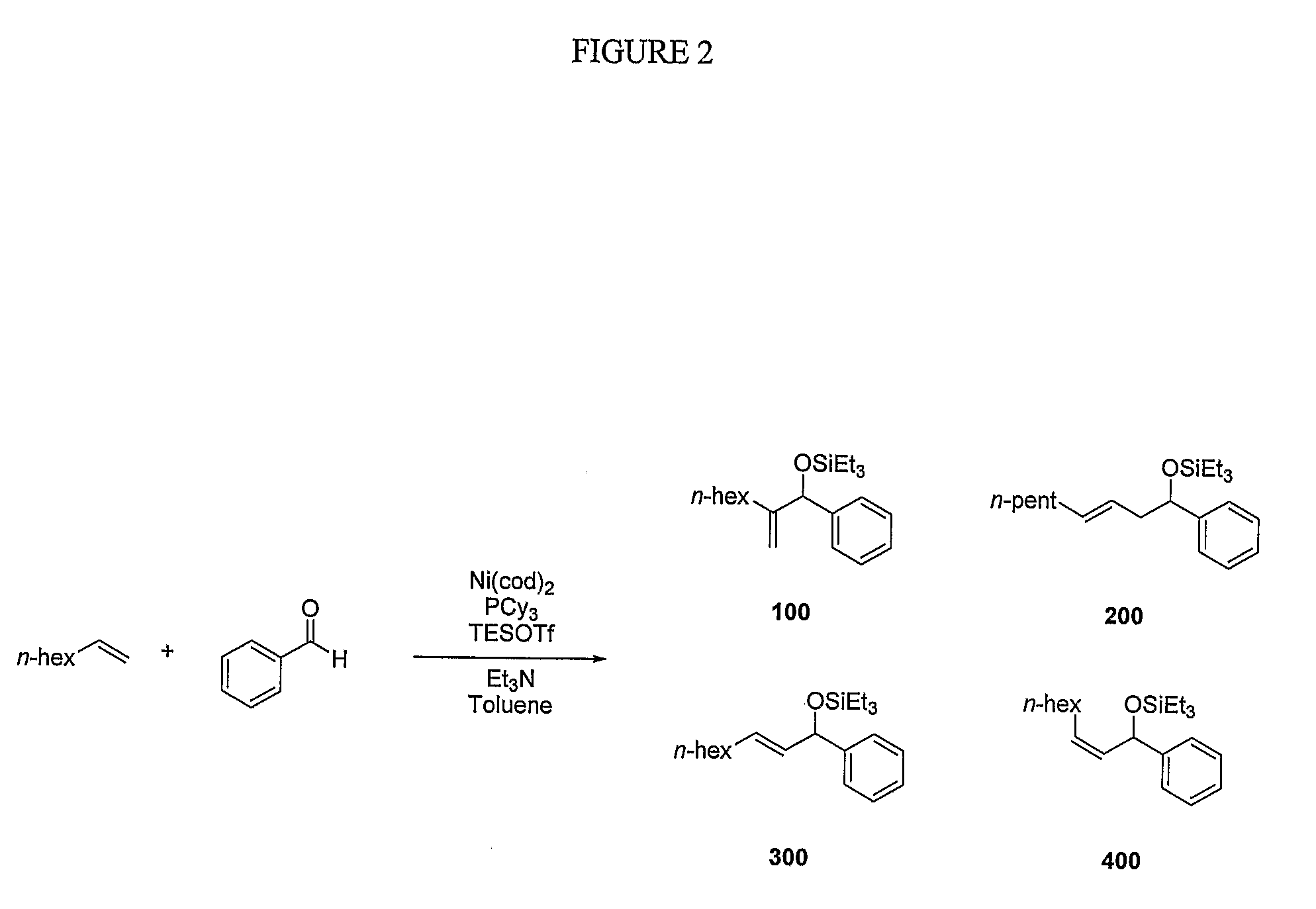Catalytic reactions involving alkenes
a catalytic coupling reaction and alkene technology, applied in the direction of organic compound/hydride/coordination complex catalyst, physical/chemical process catalyst, group 3/13 element organic compound, etc., can solve the problem that the catalytic intermolecular coupling (e.g., reductive or otherwise) of these alkenes and aldehydes has not been achieved, and the current synthetic method known to the inventors has not been able to incorporate alpha-ol
- Summary
- Abstract
- Description
- Claims
- Application Information
AI Technical Summary
Benefits of technology
Problems solved by technology
Method used
Image
Examples
example 1
[0081]Several reaction conditions were varied in order to more fully investigate the nickel-catalyzed reaction between alpha-olefins and aldehydes to form silyl ethers of allylic alcohol. Investigation into the factors which influence the general mechanistic framework of the reaction may allow one to select optimal reaction conditions to produce a desired product, such as an allylic alcohol or precursor thereof. The effect of the various components (e.g., phosphine, alkene, and aldehyde) which may ligate the metal center during the reaction was studied, as well as the effect of other reaction components, such as the base and nickel source. The interactions of nickel with the phosphine, alkene, and aldehyde may govern the assembly of the oxanickellacycle, which, in turn, may determine the product distribution.
example 1a
Effect of Phosphine Ligand
[0082]One factor that may control the product ratio in the alkene-aldehyde coupling reactions includes the cone angle and / or electronic characteristics (e.g, electron-rich, electron-poor) of the phosphine ligand. In general, the use of large, electron-rich phosphines may favor the allylic alcohol product. For example, dicyclohexylphenylphosphine is electron-rich, has a large cone angle, and is observed to promote formation of the allylic coupling product as the major product. Cone angle and νCO values were obtained from Rahman, M.; Liu, H.-Y.; Eriks, K.; Prock, A.; Giering, W. P. Organometallics 1989, 8, 1-7; Tolman, C. A. Chem. Rev. 1977, 77, 313-348; Otto, S. J. Chem. Crystallogr. 2001, 31, 185190; RiihmaÈki, H.; Kangas, T.; Suomalainen, P.; Reinius, H. K.; Jääskeläinen, S.; Haukka, M.; Krause, A. O. I.; Pakkanen, T. A.; Pursiainen, J. T. J. Mol. Catal. A: Chem. 2003, 200, 81-94; and, Steinmetz, W. E. Quant. Struct.-Act. Relat. 1996, 15, 1-6. To further i...
example 1b
Effect of the Base
[0086]Various bases employed under similar reaction conditions in the coupling of ethylene and benzaldehyde, as shown in FIG. 6. In some embodiments, tertiary amines were shown to be preferred bases for the nickel-catalyzed coupling of alkenes and aldehydes. Among different types of amine bases examined in ethylene couplings, only tertiary amines were shown to provide >20% yield of coupling products (entries 1 and 3, FIG. 6). Amines that likely are able to interact with nickel to a greater degree, such as pyridine (entry 5, FIG. 6 and entry 6, FIG. 8) were not observed to be effective. No coupling products were detected when inorganic bases were used in place of triethylamine (entries 6-8, FIG. 6).
[0087]Tertiary amines were further examined in the coupling reaction of 1-octene and benzaldehyde (FIG. 7), and triethylamine was consistently superior to other tertiary amines (entries 1-4, FIG. 7). Tertiary amines smaller or larger than triethylamine compromised the yie...
PUM
| Property | Measurement | Unit |
|---|---|---|
| mol % | aaaaa | aaaaa |
| mol % | aaaaa | aaaaa |
| mol % | aaaaa | aaaaa |
Abstract
Description
Claims
Application Information
 Login to View More
Login to View More - R&D
- Intellectual Property
- Life Sciences
- Materials
- Tech Scout
- Unparalleled Data Quality
- Higher Quality Content
- 60% Fewer Hallucinations
Browse by: Latest US Patents, China's latest patents, Technical Efficacy Thesaurus, Application Domain, Technology Topic, Popular Technical Reports.
© 2025 PatSnap. All rights reserved.Legal|Privacy policy|Modern Slavery Act Transparency Statement|Sitemap|About US| Contact US: help@patsnap.com



